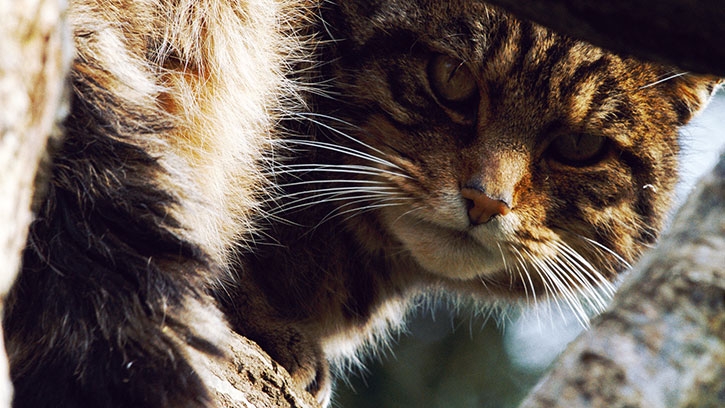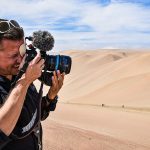
On The Trail of The Wild Cat
Jason Henwood and director Katie Wardle have a special love for Scottish Wildcats and set up a passion project highlighting this elusive creature.
WORDS Terry Hope
As wildlife subjects go there can’t be too many that are harder to film than the Scottish wildcat. For a start there are precious few of them left these days – some estimates say that there are less than 300 pure breed animals left in Scotland – and to compound things they are incredibly solitary and secretive creatures, meaning that it’s hugely unlikely you would ever happen across one in the wild.
All of which was a challenge that served to inspire filmmaker Jason Henwood and director Katie Wardle, but at the same time they were realistic enough to realise that their dream of producing a film about the enigmatic subject that had so engaged them would be anything but straightforward. Despite only having a very limited amount of time within which to work, however, the determination was there to create something that would educate the public about what makes the critically endangered wildcat so special while demonstrating how its resourcefulness has helped it, to date, survive against all the odds.
“Wildlife filmmaking has been something we’ve both been wanting to do for a very long time,” says Jason. “From my point of view it’s stemmed, of course, from watching the likes of Attenborough from a young age, but it’s only in the last year or so, since Katie and I have become more confident about our own abilities thanks to some of the amazing people that we’ve worked with, that we’ve been able to take the first steps towards making our dream come true.”
The film Jason and Katie have just completed, called The Last Highland Tiger, was part of this and, by necessity, shooting time was restricted to a single week, since it was a very much a passion project that needed to be completed in personal time, in between commercial work.
“It became clear very early on, through talking to experts who knew the species well, that the time we had wasn’t going to be enough to film these animals in the wild,” says Jason. “Other photographers and filmmakers have spent years trying to capture footage of the wildcat without much success, so we had to come up with an alternative way to work. This led us to make a decision to film the cats in two of the only enclosures in the UK that house them, the Highland Wildlife Park in Kingussie and The British Wildlife Centre near Lingfield in Surrey. We spent a day in each location, filming these beautiful animals and working closely with the keepers.”

“It’s by far the best documentary camera I’ve worked with”


IMAGES The ARRI Amira has been a great tool for shooting wildlife, including rare Scottish wildcats, which are extremely reclusive and hard to encounter in the wild.
Working in the Wild
While the assumption had been made early on that wild footage of the central character wasn’t going to be viable, there was still a determination to head out into the countryside where this creature makes its home, to film the landscape and to capture footage of the local wildlife that’s such an essential part of the wildcat’s diet.
“There was one day in particular,” recalls Jason, “where we were up at the crack of dawn to film red squirrels, then hiking up into the Cairngorms for almost three hours to focus on wild hares and rabbits before trekking back down again
at sunset.
“It was a long and strenuous day throughout which I was carrying a heavy ARRI Amira plus 45-250mm Alura lens and 2.0x Alura extender. However, as an assistant I’m lucky enough to have worked with this kit a lot, so I know it very well and was confident that its tough rugged design and ergonomic qualities would make life really simple for me out in the field. Our aim was to output in 2k for viewing on streaming platforms only, and this camera’s ability at 2k is by far the best in its range. It has the ability to switch between 100 and 200fps at the flick of a switch, and the images it produces are beautiful. Overall it’s by far the best documentary camera I’ve worked with and it’s rugged enough to be able to take anything you’re ever likely to throw at it.”
Given its weight, however, Jason needed the rest of his kit to be as light as possible, while still being solid and durable. Mike Lippmann at Miller took on the challenge to support the project and was able to come up with a solution, in the form of an ArrowX 7 fluid head and Solo 100 3 Stage Carbon Fibre Tripod. This combination, with its wide payload range, precision fluid drag and counterbalance, delivered the flexibility, speed of set up and accuracy of shot that was exactly what was needed in the production environment Jason and Katie knew they would be working in.
Filming in a Sanctuary
While, through necessity, filming in an animal sanctuary was the only way to go for shots of the wildcats, both Jason and Katie still wanted their film to have a realistic feel, and for this to happen they relied heavily on support from the centres they visited.
“Fortunately the enclosures we were working in were incredibly spacious,” says Jason, “which allowed us to move around freely without disturbing the cats, and we then just had to sit and wait for our opportunities. This also helped us to cheat our footage and almost make it look as though we were shooting on location, and the use of a shallow depth of field disguised things still further. Filming this way, however, did bring its own issues, in that we had to work hard to judge movement and retain focus on the cat whenever it did any sudden movements.”
In terms of what the film might achieve, both for its subject and for Jason’s wildlife aspirations, it’s still early days. The Last Highland Tiger debuted at the New York Wildlife Film Festival last October and will be entered into the Wildscreen Festival in Bristol next October. Then the charities involved will have the opportunity to release the film through their social networks. Jason and Katie have already undertaken their next project in New Zealand, a film entitled Bounce Back that explores the impact of earthquakes on wildlife. The aim will be to keep pushing the boundaries and to get their names out there in terms of specialising in this genre.
“Wildlife has always been the direction I’ve wanted to pursue,” confirms Jason. “However, I realise how niche and difficult this part of the industry is to get into, so for now I’ll be pursuing things slowly in the hope that life guides me in the right direction. There’s so much going on in my life and, as much as I love wildlife filmmaking, I also love working with my DPs and being around film sets, so we’ll have to wait and see where life eventually takes me.”

“Much as I love wildlife filmmaking, I also love my DPs and being around film sets”

ABOVE Jason and Katie made their film about wildcats in a wildlife sanctuary, but also shot footage in the creature’s habitat.
>> More information: The Last Scottish Tiger trailer










